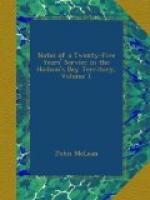The rein-deer is subject to greater annoyance from flies than any other animal in the creation; neither change of season nor situation exempts them from this torture. Their great persecutor is a species of gad-fly, (oestries tarandi,) that hovers around them in clouds during summer, and makes them the instruments of their own torture throughout the year. The fly, after piercing the skin of the deer, deposits its eggs between the outer and inner skin, where they are hatched by the heat of the animal’s body. In the month of March, the chrysalides burst through the skin, and drop on the ground, when they may be seen crawling in immense numbers along the deer paths as they pass from west to east.
The only birds observed in winter are grouse, ptarmigan, a small species of wood-pecker, butcher-bird, and the diminutive tomtit. We are visited in summer by swans, geese, ducks, eagles, hawks, ravens, owls, robins, and swallows. The eider-duck, so much prized for its down, is found in considerable numbers. The geese are of a most inferior kind, owing, I suppose, to the poor feeding the country affords; when they arrive in summer the ice is often still solid, when they betake themselves to the hills, and feed on berries.
The lakes produce only white fish, trout and carp. We took now and then a few salmon in the river, and there is no doubt that this fish abounds on the coast.
In the sea are found the black whale, porpoise, sea-horse, seal, and the narwal or sea unicorn; the horn of the latter, solid ivory, is a beautiful object. The largest I procured measured six feet and a half in length, four inches in diameter at the root, and a quarter of an inch at the point. It is of a spiral form, and projects from near the extremity of the snout; it presents a most singular appearance when seen moving along above the surface of the water, while the animal is concealed beneath.
The geological features of the country present so little variety, that one versed in that interesting science would experience but little difficulty in describing them; a mere outline, however, is all I can venture to present.
Along the sea-coast the formation is granitic syenite; then, proceeding about forty miles in the direction of South River, syenite occurs, which, about sixty miles higher up, runs into green stone: very fine slate succeeds. At the height of land dividing the waters that flow in different directions, into Esquimaux and Ungava Bays, the formation becomes syenitic schist, and continues so to within a short distance of the great fall on Hamilton River; when syenite succeeds; then gneiss; and along the shores of Esquimaux Bay syenitic gneiss, and pure quartz: lumps of black and red hornblend are met with everywhere. The country is covered with boulders rounded off by the action of water, most of which are different from the rocks in situ, and must have been transported from a great distance, some being of granite—a rock not to be found in this quarter.




